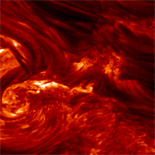
MPI
Astronomy 383C - Spring 2009
STELLAR ATMOSPHERES
MWF 11:00-12:00 · RLM 15.216B · Unique No. 48580
Professor
RLM 16.236 · (512) 471-3404 · email
|
|
|
LEVEL:
Böhm-Vitense, Introduction to Stellar Astrophysics: Volume 2, Stellar Atmospheres
Mihalas, Stellar Atmospheres
Gray, Observations and Analysis of Stellar Photospheres
Rybicki and Lightman, Radiative Processes in Astrophysics
SYLLABUS
Summary of Observational Data: Motivations for studying stars. Spectral and luminosity classification. Relation of theory and observation.
Elements of Radiative Transfer Theory: Definitions. Emission, absorption, and scattering. Equation of transfer, radiative equilibrium.
Gray Atmospheres: Milne's equation. Two-stream and Eddington approximations. Emergent flux and limb darkening.
Local Thermodynamic equilibrium (LTE): Elements of statistical mechanics. Perfect gases and the Saha equation. Conditions for LTE. Depression of the adiabatic gradient in a partial ionization zone.
Non-LTE: Rate: Rate equations. Radiative and collisional rates; departure coefficients. Calculation of Einstein coefficients and collision cross-sections.
Continuum Opacity: Opacity sources in high-, intermediate-, and low-temperature stellar atmospheres.
LTE Continuum model Atmospheres: Basic equations. Numerical solution of transfer equation: (-iteration; Kurucz's and Feautrier's methods. Temperature-correction procedures.
Results and Comparison With Observations: Absolute energy distributions. The Balmer jump. Sample model atmosphere calculation. Flux distributions for sample model stars. Effect of absorption edges on atmospheric structure, line-blanketing, molecule formation.
Mixing Length Theory: Convection and partial ionization zones. Simple phenomenological models.
Line Spectra: Line absorption profiles. Natural broadening and the Lorentz profile. Doppler broadening and the Voigt profile. Collisional broadening. Stark broadening, Inglis Teller formula.
Line Transfer Problem.: Line transfer equation: pure scattering lines and pure absorption lines. Center-to-limb variations. Schuster mechanisms. Curve of growth and abundance determinations. Model atmosphere line calculations. Line blanketing theory, LTE line formation.
Moving Atmospheres: Modeling stellar atmospheres with winds require hydrodynamic NLTE treatment. Development of a first-principles approach to the problem. Applications to Hot stars.